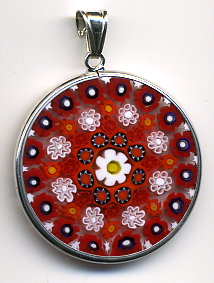Millefioriglas

Millefioriglas (from Italian Millefiori "thousand flowers") is a form of glassware that has been known since ancient times . Millefioriglas is made by either covering a glass rod with new, differently colored layers of glass, or by fusing several colored glass rods into a larger one. Slices are then cut from these sticks, which are called murrine (singular murrina ) in Italian and English . These plates, discs or ribbons are then laid out in a mold and then slowly melted. So overlay glass and fusing techniques were used. After cooling, the result is opaque vessels that have the same pattern inside and out.
In ancient times, Italy and the eastern Mediterranean were production centers for this elaborate glass. They were particularly popular in the early days of the Empire. Various vessels were made, in particular plates, bowls and bowls, but also pearls, gemstones, pendants and miniatures. In early modern Venice , the glass was again produced in large numbers. It was during this time that the glass got its name.
In the 19th century, the manufacturing technique was forgotten. At the suggestion of Heinrich von Minutoli, various glassmakers tried to rediscover the manufacturing techniques. Wilhelm Fuss and Franz Pohl, who worked in the Matterne glassworks in Hoffnungsthal in Silesia, experimented with the manufacture of mosaic glasses. In the summer of 1833, Fuss succeeded, with the assistance of the director of the Berlin Trade Institute, Beuth.
The technology is still used today for jewelry glass. The mosaic glass is similar to the millefiori glass . The thread glass is a further development .
Paperweight , around 1950
literature
- Arturo Oliver Foix: Millefiori glass in classical antiquity. In: Journal of Glass Studies 10, 1968, pp. 48-70.
- Gertrud Platz-Horster : Antique glasses. Antikenmuseum Berlin, Berlin 1976, pp. 29–33.
- Millefiōri . In: Meyers Großes Konversations-Lexikon . 6th edition. Volume 6, Bibliographisches Institut, Leipzig / Vienna 1906, pp. 839–840 .
Web links
Individual evidence
- ↑ The history and possibilities of the Murrine technique are u. a. on the MuranoNet , Fusion Art Glass websites ( Memento of the original dated August 16, 2016 in the Internet Archive ) Info: The archive link was inserted automatically and has not yet been checked. Please check the original and archive link according to the instructions and then remove this notice. and TwistedSifter , accessed August 2016
- ^ Dorothea Minkels : Alexander von Minutoli, the founder of the 1st arts and crafts museum in the world (1844) . Norderstedt 2018, ISBN 978-3-7460-6982-1 , p. 139-141 .




